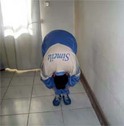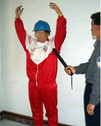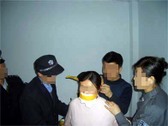According to an incomplete estimate, the cruel tortures at the Masanjia Forced Labour Camp in the past seven years have resulted in at least five deaths of Falun Gong practitioners. Seven practitioners suffered a mental collapse, and many practitioners sustained permanent disabilities.
According to some of the persecution reports on the Clearwisdom website, we compiled nearly 100 torture methods used at the Masanjia Forced Labour Camp on Falun Gong practitioners. Due to limited time and resources, we will only show here the 20 most commonly used torture methods and other acts of physical abuse.
Torture Names
Torture method 1: body folding
Torture method 2: torturing the arms
Torture method 3: handstand (standing upside-down)
Torture method 4: hanging upside-down
Torture method 5: sealing the mouth
Torture method 6: tie-up
Torture method 7: handcuffing
Torture method 8: sitting with arms raised
Torture method 9: split legs and head against the floor
Torture method 10: sitting on a small stool
Torture method 11: sitting in a basin with cold water
Torture Reenactment Photos and Illustrations
Torture method 1: body folding
 |  |
| Photo 1 | Photo 2 |
 |
| Photo 3 |
The Falun Gong practitioner's upper body and legs are forced to form a 45-degree angle; his legs are kept straight and his head points downward. His arms are raised straight up from behind his back to the maximum extent, or down reaching his heels. Many practitioners were dragged to the toilet and tortured this way. Staying in this posture for a long time results in cramps, soreness and pain in the arms and legs. Falun Gong practitioners Zou Guirong, who was tortured to death, and Ge Chunling were tortured this way.
 |
| Photo 4 |
Torture method 2: torturing the arms
The Falun Gong practitioner is forced to raise both arms without letting them down. He is forced to stay awake 24 hours a day, with guards watching him. If he relaxes a little, the guards shock him with electric batons or beat him. The guards also pinch the practitioner's body until it turns black and blue. The practitioner feels sore and painful from holding the arms up for a long time; his body trembles and he is soaked in sweat.
Torture method 3: handstand (standing upside-down)
 |  |
| Photo 5 | Photo 6 |
The practitioner is forced to do a handstand next to a wall, with his hands supporting his body and his legs pointing straight up. The inmates and guards hold the practitioner's legs and feet while some other guards shock the practitioner's chest near the heart. Most of the victims suffer dizziness and have bloodshot eyes. Their hearts speed up and they have difficulty breathing from the electric shock and upside-down position.
Torture method 4: hanging upside-down
 |  |
| Photo 7 | Photo 8 |
The practitioner's legs are pulled through the bottom railing of a bunk bed with his head pointing downward in mid-air. His arms are tied behind his back. As a result of being positioned upside down, the practitioner usually experiences blood rushing to the head, which causes severe swelling of the head. Several minutes later he suffers from shortness of breath and dizzy spells. Guard Wang Xiuju tortured practitioner Zhang Xiuling this way and ordered collaborators1 to hit her head until her eyes turned black and blue. They even burned her face with a lit piece of paper.
Torture method 5: sealing the mouth
 |  |
| Photo 9 | Photo 10 |
 |
| Photo 11 |
The practitioner's mouth, face and head are wrapped in tape with only the eyes exposed. The practitioner's arms are pulled behind his back and immobilised with tape, and then the evildoers brutally beat him. Guard Ren Hongzan gagged practitioner Liu Dianqin with a sanitary napkin and then fixed the napkin in place with several rounds of tape. Ren Hongzan then loudly read a Dafa-slandering book next to Liu Dianqin's ear.
Note
1. "Collaborators": Former practitioners who have turned against Falun Gong under brainwashing and torture. They are then made to assist in brainwashing and torturing practitioners.
(To be continued)
Chinese version available at http://www.minghui.org/mh/articles/2006/3/1/121865.html
* * *
You are welcome to print and circulate all articles published on Clearharmony and their content, but please quote the source.










 more ...
more ...